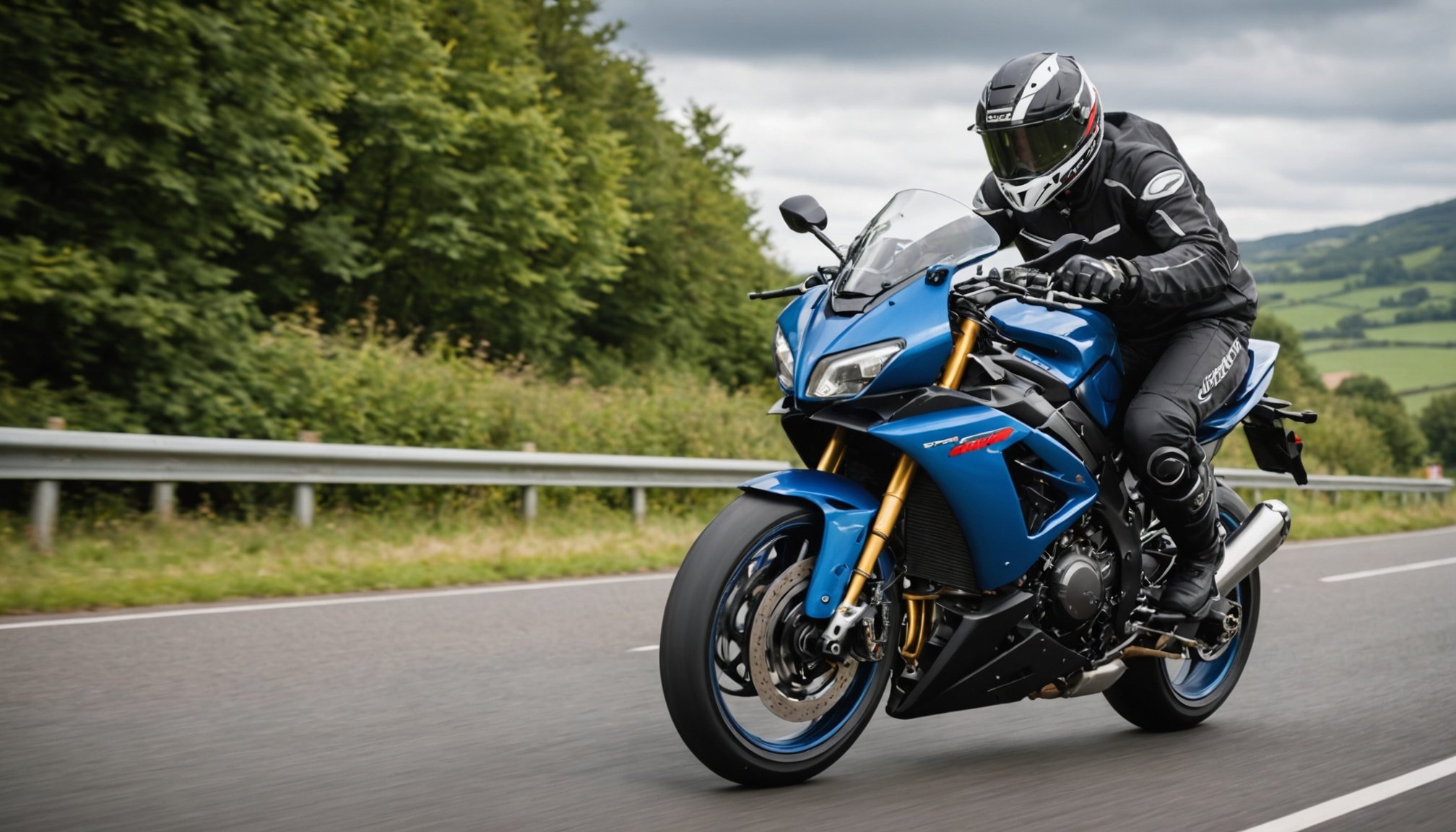Mastering Adjustable Sport Bike Suspension: The Best Settings for Conquering UK’s Twisting Roads
Understanding the Importance of Adjustable Suspension
When it comes to riding sport bikes, especially on the twisting roads of the UK, having the right suspension setup can make all the difference between a exhilarating ride and a precarious one. Adjustable suspension is not just a luxury, but a necessity for serious riders who want to optimize their bike’s performance for various riding conditions.
“Adjustable suspension components, such as forks and shock absorbers, allow for better handling during cornering and braking,” notes an expert from Motorcycle Creak. “Improved damping and spring rates provide greater stability, helping the rider maintain control even at high speeds or on uneven surfaces”[1].
Also read : Ultimate Guide: How to Properly Check and Adjust Your Sport Bike Suspension Preload for a UK Track Day
Key Components of Adjustable Suspension
Front Suspension: The First Line of Defense
The front suspension of your bike is crucial for stability and control. Here are some key components and adjustments you should consider:
-
Fork Valves and Springs: Upgrading to aftermarket fork valves, such as the Intiminator valves, can significantly improve the compliance and stability of your front forks. These valves dynamically adjust damping, ensuring that the front tire stays connected to the road, even under braking or when hitting bumps[2].
This might interest you : Essential Guide to Winterizing Your Sport Bike in the UK: Key Steps to Avoid Engine Damage
“`plaintext
Benefits of Upgraded Fork Valves: -
Reduced brake dive
-
Improved traction
-
Enhanced stability in curves
-
Smoother ride over bumps
“` -
Preload and Damping Adjustments: Most aftermarket forks offer adjustable preload, compression, and rebound settings. These adjustments allow you to tailor the suspension to your weight and riding style. For example, lighter riders may prefer lower preload settings, while heavier riders may need higher settings to maintain proper sag[4].
Rear Suspension: The Backbone of Stability
The rear suspension is equally important, as it affects the overall stability and handling of the bike.
-
Rear Shock Upgrades: Installing a premium rear shock absorber with adjustable features can dramatically improve your bike’s performance. Look for shocks that offer preload adjustments, as well as compression and rebound damping settings. This allows you to fine-tune the suspension based on your weight and the specific demands of the road[1].
“`plaintext
Benefits of Upgraded Rear Shocks: -
Enhanced handling and stability
-
Improved traction
-
Better braking performance
-
Customizability for different riding styles
“`
Setting Up Your Suspension for UK Roads
Determining the Right Sag
Before you start adjusting your suspension, it’s crucial to set the right sag. Sag refers to the amount of suspension travel used under the rider’s weight.
-
Front Sag: To set the front sag, inflate the air spring in the fork to the recommended pressure for your weight. Then, with your riding gear on, get a friend to hold the bike while you sit in your normal riding position. Ensure the rubber O-ring around the fork stanchion is pushed up against the wiper seal. This will give you the correct sag measurement[4].
-
Rear Sag: The process is similar for the rear shock. Sit on the bike in your normal riding position and measure the sag. The recommended sag is usually around 25-30% of the total suspension travel.
Adjusting Damping Settings
Damping settings are critical for how your suspension responds to road conditions.
-
Rebound Damping: Rebound damping controls how quickly your suspension resets after absorbing an impact. Start by setting the rebound damping on the rear shock, then match the fork’s rebound feel to the shock’s. The goal is to have the suspension oscillate only once after a good-sized compression, such as riding off a kerb[4].
“`plaintext
Steps to Set Rebound Damping: -
Turn the dial/lever towards the ‘+’ or tortoise symbol until the shock only oscillates once.
-
Session the trail section and decrease the damping until the suspension can track the ground and recover between hits.
-
Match the fork’s rebound feel to the shock’s using the same method.
“` -
Compression Damping: Compression damping controls how the suspension responds to impacts. Start with the recommended settings or set the low-speed compression (LSC) in the middle and the high-speed compression (HSC) fully open. Adjust the dial one or two clicks in each direction until you get the suspension behaving in the way that best suits the terrain and your riding style[4].
Practical Tips for Riders
Riding Style and Conditions
Your riding style and the conditions of the road play a significant role in how you should set up your suspension.
-
Sport Riding: For aggressive sport riding, you may want to set your suspension to be stiffer, with higher compression and rebound damping settings. This will help maintain stability during high-speed cornering and braking.
-
Touring: For long-distance touring, a softer setup with lower compression and rebound damping can provide a more comfortable ride, absorbing bumps and irregularities in the road.
Maintenance and Adjustment
Regular maintenance and adjustments are key to keeping your suspension performing optimally.
-
Check and Adjust Sag Regularly: Ensure that the sag is set correctly for your weight and riding style. This will prevent uneven tire wear and maintain optimal handling.
-
Use the Right Tools: Invest in a good quality suspension pump and tools to make adjustments easier and more precise.
Real-World Examples and Anecdotes
Upgrading a Harley-Davidson
One rider who upgraded the suspension on his 2013 Harley-Davidson 883 Iron with progressive springs and Intiminator valves noted a significant improvement in the ride. “The ride is now a lot tighter and more comfortable. I don’t even notice bumps that would have jarred me before,” he said. This upgrade not only improved the comfort but also enhanced the stability and handling of the bike[2].
Tuning for Mountain Roads
For riders who frequently tackle mountain roads, fine-tuning the suspension is essential. A rider who regularly rides the twisting roads of the Scottish Highlands shared, “I adjusted my rear shock to have a bit more compression damping to handle the rough terrain. It made a huge difference in stability and control, especially during downhill sections.”
Comparative Table: Suspension Upgrades
Here is a comparative table highlighting the key benefits and considerations of different suspension upgrades:
| Upgrade | Benefits | Considerations | Cost Range |
|---|---|---|---|
| Aftermarket Fork Valves | Improved traction, reduced brake dive, enhanced stability | Requires precise installation, may need additional tools | $100-$300 |
| Premium Rear Shocks | Enhanced handling, improved traction, better braking performance | Adjustable features may require professional setup | $200-$500 |
| Complete Suspension Kits | Comprehensive solution, matched front and rear components | Higher cost, may require professional installation | $500-$1,000 |
| Brake System Upgrades | Improved stopping power, reduced brake fade | Higher cost, may require professional installation | $300-$700 |
Mastering adjustable sport bike suspension is a journey that requires patience, understanding, and practice. By knowing how to set up your suspension correctly, you can transform your riding experience, making it safer, more comfortable, and more exhilarating.
As one experienced rider put it, “The right suspension setup is like having an extra pair of hands on the road. It gives you the confidence to push your limits and enjoy the ride to the fullest.”
Whether you’re tackling the twisting roads of the UK or exploring new adventure routes, understanding and adjusting your bike’s suspension will make every ride a memorable one. So, take the time to learn, adjust, and fine-tune your suspension – your bike, and your riding experience, will thank you.






